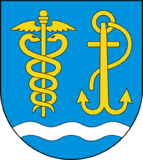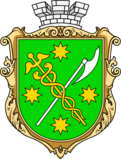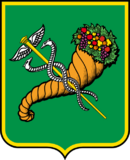Caduceus facts for kids
The caduceus (say "ka-DOO-see-us") is a special staff. It has two snakes wrapped around it. Sometimes, it also has wings at the top. This staff was carried by Hermes, the messenger god in Greek mythology. In Roman myths, it was carried by Mercury, who was also a messenger of the gods.
The word "caduceus" comes from an old Greek word meaning "herald's wand." A herald was a messenger who carried important news. The caduceus showed that the person carrying it was a messenger.
Some people believe the idea for the caduceus came from ancient Mesopotamia. There, a god named Ningishzida had a symbol like it. This symbol with two snakes goes back thousands of years, to around 4000 to 3000 BC.
The caduceus is a symbol for Hermes and Mercury. Because of this, it represents things like trade, business, and messages. It was also used as a symbol for the planet Mercury in astronomy and astrology. People even thought the staff could make people sleep or wake them up. Some stories say it could even bring the dead back to life!
Since it's linked to Mercury, the caduceus also stands for business and talking things out. This is because Mercury was also the god of trade and negotiation. It's a very old symbol for these ideas. The caduceus is also a symbol for printing, because Mercury was linked to writing and speaking well.
It's important not to confuse the caduceus with the Rod of Asclepius. The Rod of Asclepius has only one snake and no wings. It is the true symbol for medicine and healthcare. Even though the caduceus is sometimes used for medical groups, many health experts don't think it's the right symbol. This is because the caduceus is mostly about business and messages, not healing.
Contents
The Caduceus in Ancient Times
The caduceus has been shown in art for a very long time. Ancient Greeks and Romans often drew it. You can see it on old coins and pottery.
- The Caduceus in classical imagery
Modern Uses of the Caduceus
Today, the caduceus is still used in many ways. It often represents trade and communication.
Symbol for Business and Trade
A simpler version of the caduceus is often found in dictionaries. It's listed as a "commercial term." This shows its strong link to business. In this simpler form, the staff might have small wings. The snakes might be gone or just a small ring.
Many customs services use the caduceus as their symbol. Customs services check goods coming into a country. For example, the customs agencies of Bulgaria, Slovakia, and Belarus use it. The customs service of China also uses it. The symbol shows how the caduceus is about borders, messengers, and trade. The Federal Customs Service of Russia has a caduceus on its emblem. Some universities focused on trade also use it in their symbols.
Caduceus on Coats of Arms and Flags
The caduceus is also a popular symbol on coats of arms and flags around the world. It can be seen on the symbols of cities and towns. This shows its importance as a symbol of commerce and communication in different places.
- Caduceus in coats of arms and flags
-
Coat of arms of Lassay-les-Châteaux, France
-
Coat of arms of Saint-Pantaléon, France
-
Coat of arms of Gmina Nur, Poland
-
Coat of arms of Irbit, Russia
-
Coat of arms of Bengtsfors Municipality, Sweden
-
Coat of arms of Balta, Ukraine
-
Coat of arms of Berdychiv, Ukraine
-
Emblem of the Volapük language
-
Customs flag of Belarus, with a Caduceus crossed with a golden key at the center
-
Customs flag of China, with a Caduceus crossed with a golden key at the lower fly half
-
Flag of the City of Brisbane, Australia
-
Flag of Vancouver Island, Canada (unofficial)
See also
 In Spanish: Caduceo para niños
In Spanish: Caduceo para niños
- Aaron's rod
- Rod of Asclepius
- Serpent (symbolism)
- Staff of Moses




















